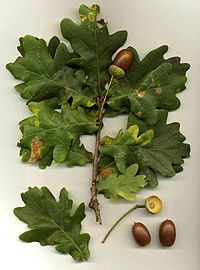
Photo from wikipedia
Abstract The primary objective of this study was to evaluate the growth, genetic predisposition and potential for early fructification of pedunculate oak trees (Quercus robur L.) using two different planting… Click to show full abstract
Abstract The primary objective of this study was to evaluate the growth, genetic predisposition and potential for early fructification of pedunculate oak trees (Quercus robur L.) using two different planting stocks: Root Production Method (RPM®) and Cell Grown (CG). The second objective was to investigate the effect of crown clearance on acorn production. This study was undertaken between 2001 and 2016 at an experimental site at Castlearchdale in Northern Ireland initially comprising of 150 CG and 150 RPM® derived one-year old Q. robur seedlings. Both tree seedling groups were each subdivided into two groups of 75 trees based on height: CG1 (20–50 cm); CG2 (>50 cm); RPM® 1 ( 76 cm). Viable acorns were produced by each category of tree in the seventh year after planting: CG1 - 1 tree (1.3%); CG2 - 2 trees (2.7%); RPM®1 - 6 trees (8%) and RPM®2 - 12 trees (16%). The RPM® trees were significantly (p The potential of RPM® planting stock to enhance home grown seed production in Britain and Ireland is discussed in relation to fructification dynamics of oak trees, and physiological and climatic conditions.
Journal Title: Forest Ecology and Management
Year Published: 2021
Link to full text (if available)
Share on Social Media: Sign Up to like & get
recommendations!